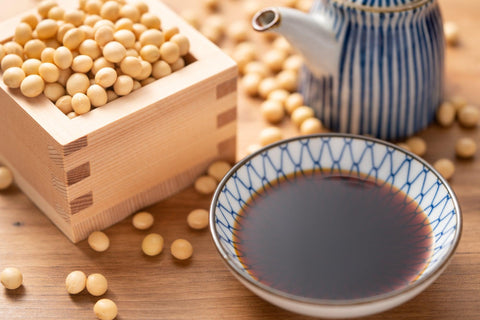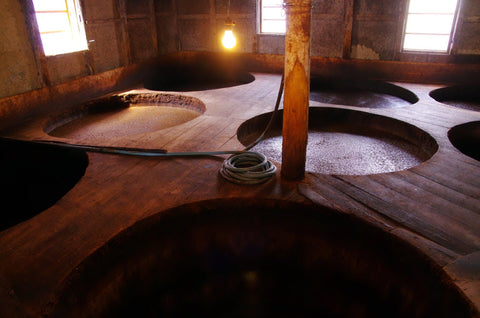
Jump to:
Shoyu, or Japanese soy sauce (in this post, we will use the term Shoyu to distinguish it from Chinese soy sauce and other varieties) is a staple condiment of Japanese cuisine. Although there are many types of Shoyu (check out this article for a great introduction to the topic), over 80% of the Shoyu consumed in Japan is called “Koikuchi Shoyu”, meaning dark soy sauce.
In this blog post, we will look at its history, where it is produced, and how it is made, and compare it with Usukuchi Shoyu, looking at regional preferences and the reasons behind the Kansai/Kanto split. We will also look at the ways Koikuchi Shoyu is used in food, before rounding up by introducing some popular Japanese brands that you might like to try.
Origins Of Koikuchi Shoyu

Shoyu, based on the fermented Chinese food of “Sho” (pronounced “Jiang” in Chinese), was first manufactured and sold in the Kansai region of Japan. The early production of soy sauce resembled something similar to what is known as “Tamari” soy sauce today.
Although an important ingredient in life for people from Kansai by the end of the sixteenth century, at that time it was not yet manufactured in the Kanto region. It appears they were aware of soy sauce at that time, but only as “Kudari” shoyu. The term “Kudari” indicated that it had been brought there from the capital (which at that time was Kyoto).
Production of Shoyu in Kanto did not begin in earnest until the start of the Edo period at the end of the 17th Century. At that time, there were few rice paddies able to thrive in the volcanic ash soil of the Kanto region. Therefore, areas such as Noda and Choshi in Chiba Prefecture, with access to rivers and fields of soybeans and wheat nearby, focused on utilizing such ingredients in Shoyu production, and these early Edo production strongholds are still the main production areas in the Kanto region today.
Experimentation began with different production techniques and balances of ingredients and, as the preference for a darker Shoyu with a stronger flavor emerged in the Kanto region, what we know now as Koikuchi Shoyu was born.
How Is Koikuchi Shoyu Made?

While the base ingredient is different, the method of making Shoyu bears similarities to that of making Japanese sake.
Koikuchi Shoyu uses the honjozo method of production in which roasted wheat and steamed soybeans (in a 1:1 ratio in the case of Koikuchi Shoyu) is left to ferment for at least six months before being pasteurized and filtered, and then aged or bottled and sold.
The longer it is fermented, the more proteins are broken down, which further accentuates its dark brown color and complex flavors. In the case of Koikuchi Shoyu, a longer period of fermentation is used to produce its dark color and draw out its strong flavor and rich aroma.
Koichuchi Shoyu vs Usukuchi Shoyu

Although there are many types of Shoyu on the market, the two main players are undoubtedly Koikuchi Shoyu and Usukuchi Shoyu, or light(in color) Shoyu. As described above, Koikuchi Shoyu was developed based on innovations made during the Edo period with the boom in production in Chiba Prefecture. Usukuchi Shoyu, on the other hand, was developed later in Kansai, where the bulk of it is still consumed.
Even though both types use an approximate one-to-one ratio between wheat and soybeans, the fermentation process for Koikuchi Shoyu tends to be much longer, which gives it a more dominant flavor and aromatic fragrance. In addition to its saltiness (which is surprisingly less than its light-colored counterpart), Koikuchi Shoyu has a strong umami flavor, a refreshing acidity, and the uncanny ability to be both sweet and bitter at the same time.
Simply put, whereas Usukuchi Shoyu is formulated in a way that brings out the taste, fragrance, and color of the food it is cooked with, Koikuchi Shoyu is used as a condiment with a more dominant role in affecting the overall taste and presentation of the food it accompanies.
There is also a difference in the ingredients used. Whereas Koikuchi Shoyu uses only soybeans, wheat, and salt, Usukuchi Shoyu often uses rice in addition to these three ingredients, and Amazake (fermented rice drink) may also be added to give it a mellow and elegant, sweet flavor, and mild aroma. You can get more information about Usukuchi Shoyu here.
Reasons For The Kanto-Kansai Shoyu Divide

So why is Koikuchi Shoyu popular in Kanto, whereas Usukuchi Shoyu is the type favored in Kansai? Probing the reasons behind this reveals historical, environmental, and cultural factors.
As described previously, when Koikuchi Shoyu was formulated in Kanto, the region was plagued with volcanic ash soil in the Kanto region soil, and it was not possible to cultivate delicious vegetables under these conditions. Therefore, a condiment with a more dominant taste was more suitable as it added flavor to compensate for the inferior quality of the vegetables. The same goes for the fish caught in the Kanto area. Unlike the white fish caught around the Kansai area, the blue and red-flesh fish caught off the Chiba shores had a strong fishy smell that could be masked by the strong aroma of Koikuchi Shoyu.
In terms of environmental factors, the hardness of the water in the respective regions also had an effect on the type of Shoyu preferred. As the water in the Kansai region is soft, it is ideal for making good “dashi” broth using kelp, and, therefore, chefs in the region favor a type of Shoyu that accentuates rather than covers this base taste.
In contrast, this good “dashi” is not so easily produced with the hard water prevalent in the Kanto region. Kanto chefs, therefore, are more reliant on the umami of Koikuchi Shoyu to influence the taste of the cuisine.
Lastly, “Kyo Ryori”, popular in the Kansai region, values presentation and the color of food, and this is another reason for the spread of the visually unobtrusive Usukuchi Shoyu.
How Is Koikuchi Shoyu Used In Food?

Koikuchi Shoyu is both widely used as a condiment for the meal table and as an ingredient in the cooking itself.
It is poured over tofu and other soybean-based dishes such as Atsuage (deep-fried tofu) to add saltiness and umami to otherwise plain food. It is also used as a dipping sauce, either by itself or with Wasabi (green Japanese horseradish) or Karashi (Japanese mustard) when you want to add a little spice to the dip.
When it comes to including it in cooking, as it has a richer flavor and deeper taste than Usukuchi Shoyu, it is recommended for simmered or Teriyaki dishes that require a more full-bodied flavor. This also makes it ideal for use in marinades and stir-fries.
Koikuchi Shoyu – Where To Get It
A vast array of Shoyu is available at supermarkets across Japan, as well as in Asian food shops, and increasingly supermarkets, in many other countries. Having such a huge number of varieties to choose from, however, is not always a good thing and it may be hard to find what you want or even work out the difference between each type.
A great place to start your Shoyu journey is the collection on the Japanese Taste website, where a comprehensive range of Koikuchi Shoyu brands is available, each with a description outlining the type, ingredients, and recommended uses. We have introduced a few of these below.
The Best Koikuchi Shoyu Brands And Products

Hiroshima-based Shoyu brewery Teraoka has produced this excellent full-bodied organic Koikuchi Shoyu containing nothing but organic soybeans, organic wheat, and salt, with the distinctively luring aroma of cedar, which is a result of its 3-year fermentation process in cedar barrels. For those on a slightly tighter budget, Teraoka also offers this more economical non-organic offering that also uses its traditional barrel-brewing process. The rich taste of these Shoyu offerings makes them ideal used either as a condiment on the meal table or as the base ingredient in a soup or hotpot-based dish.
Another great Koikuchi Shoyu is Takesan's Kishibori Shoyu. This offering from Takesan is classed as a raw Shoyu under JAS(Japanese Agricultural) standards as it includes no preservatives or additives (other than salt).
This Koikuchi Shoyu, which has a unique distinctive aroma, a truly rich flavor, and a beautiful amber color, is made from selected whole soybeans, wheat, and sun-dried salt, naturally brewed in cedar barrels for over a year, and pressed directly from the moromi without pasteurization. It is perfect for adding flavor in cooking meat and other dishes, or as a dipping sauce.
Another exciting offering on the Japanese taste website is this organic Koikuchi Shoyu from Adachi, a local brewer in Hyogo Prefecture, Kansai. Adachi have shunned modern trends for using soybeans from overseas, shorter brewing times and preservatives, and truly gone “back to basics” to bring you Shoyu containing nothing but the three main ingredients. No corners are cut and Adachi ferment it in wooden barrels for over a year, to deliver an excellent all-purpose Koikiuchi Shoyu of the utmost quality to your meal table and kitchen. Among its many uses, it gives a delicious “umami” boost to marinades, sauces, and soups, as well as being an excellent accompaniment to cold dishes, such as Sashimi and Hiyayakko (chilled tofu).
Last, but not least, is this Koikuchi Shoyu from Kansai-based Shoyu producer, Suehiro, which was founded in 1879. Although ostensibly focused on Usukuchi Shoyu due to its Tatsuno roots, the company, which has dedicated itself to following best practices in its craft, has also produced this naturally brewed Koikuchi Shoyu made only from carefully selected Japanese whole soybeans, Japanese wheat, and sun-dried, matured slowly, harnessing the full power of nature to bring you a product of the finest quality.
Koikuchi Shoyu – The Dominant Japanese Soy Sauce

Koikuchi Shoyu has the lion’s share of the Japanese Shoyu market, and particularly in the Kanto region, it is considered the default, go-to Shoyu as a condiment and dipping sauce on the meal table, as well as for use in flavoring cooking.
Generally, if the type of Shoyu listed in a recipe is not specified, it refers to Koikuchi Shoyu. It is also used as an all-purpose replacement when specialist Shoyu, such as Sushi Shoyu, are not available.
Koikuchi Shoyu In Conclusion?
With its previously mentioned dominant share of the Shoyu market, Koikuchi Shoyu can be considered the default type of Shoyu.
Have you tried Koikuchi Shoyu before? Do you have a favorite brand? Let us know in the comments.


0 comments